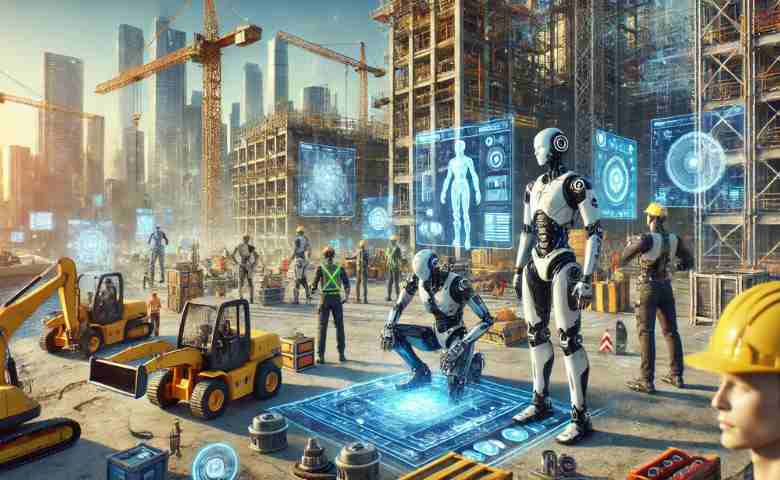Last Updated on March 15, 2025 by Admin
In 2030, as a site engineer on a busy construction site, imagine receiving the news that 20% of your workforce is now composed of humanoid robots—machines that never tire, work in any condition, and are maintained at a fraction of human cost. While this scenario may seem straight out of a sci‑fi thriller like Netflix’s Subservience (2024), it underscores an essential truth: to thrive in a tech‐driven construction industry, both traditional workers and engineers must adapt their skill sets. Below are key areas to focus on, along with detailed explanations and links to authoritative resources that help paint the full picture.
Table of Contents
1. Digital Literacy and Data Analytics
Why It Matters:
Automation isn’t just about physical labor; it’s powered by digital systems. Proficiency in digital tools—from smartphones to specialized construction software—enables workers and engineers to monitor projects, interpret data, and make informed decisions in real time.
Practice 15+ AI-generated technical and HR interview questions for Civil, BIM, QS, Planning, HSE and Construction roles. Get instant feedback, improved answers, a 7-day improvement plan, and a full PDF report. Designed exclusively for construction professionals.
One free full interview session included. No credit card required.
Key Skills:
- Data interpretation: Understanding sensor data, real‑time monitoring outputs, and performance metrics.
- Software proficiency: Using Building Information Modeling (BIM) and project management platforms to coordinate work between humans and robots.
Learn More: How Engineers Are Embracing Automation and Robotics – PlanRadar
2. Robotics Operation, Maintenance, and Troubleshooting
Why It Matters:
With humanoid robots increasingly on the job, the ability to operate, maintain, and troubleshoot these machines becomes critical. Rather than seeing robots solely as competitors, workers can view them as tools that enhance productivity.
Key Skills:
- Basic robotics operation: Learning to interface with robot control systems.
- Preventive maintenance: Routine checks and minor repairs to ensure robots function optimally.
- Troubleshooting: Quick diagnosis and resolution of technical glitches to minimize downtime.
Learn More: Built Robotics – Wikipedia provides background on how companies are deploying these systems.
3. Integration of AI and Automation Technologies
Why It Matters:
The next wave of construction technology is driven by AI—from predictive maintenance to autonomous task planning. Site engineers need to understand how AI algorithms operate and how to harness these systems for better planning, safety, and cost control.
Key Skills:
- Understanding AI basics: Knowing how AI can optimize workflows.
- Interfacing with autonomous systems: Utilizing platforms that allow human oversight of robot operations.
- Embracing new protocols: Adapting to evolving standards in construction automation.
Learn More: Long on Ambition, Short on People: How the Skills Gap Could Scupper UK’s Bid to Decarbonise Buildings – Reuters
4. Advanced Project and Resource Management
Why It Matters:
Automation accelerates project timelines and changes workflow dynamics. Project managers and site engineers will need enhanced skills to plan, schedule, and oversee projects where human and robotic workforces coexist seamlessly.
Key Skills:
- Dynamic scheduling: Leveraging digital tools for real‑time adjustments.
- Resource allocation: Balancing human talent with robot capabilities to maximize efficiency.
- Risk management: Identifying and mitigating risks in a hybrid workforce environment.
Learn More: The Role of Robotics in Modern Construction: Pros & Cons for Construction Workers – FBR Recruitment
5. Safety and Compliance in a Robotic Environment
Why It Matters:
While robots can take on dangerous tasks, they introduce new safety protocols and compliance challenges. Understanding and managing these changes is vital for protecting workers and maintaining project integrity.
Key Skills:
- Robotic safety protocols: Training in both traditional safety measures and those specific to automated machinery.
- Regulatory compliance: Staying updated with industry standards and new regulations regarding automation.
- Emergency response coordination: Developing procedures that integrate human and robotic responses in emergencies.
Learn More: How Robots Will Save Workers Six Weeks a Year – The Australian
6. Soft Skills: Adaptability, Communication, and Collaborative Problem-Solving
Why It Matters:
Automation will not eliminate the need for human creativity and leadership. Instead, it will shift the emphasis toward roles that require strategic oversight, complex decision-making, and effective communication between human and machine teams.
Key Skills:
- Adaptability: Embracing continuous change and learning new technologies.
- Effective communication: Bridging the gap between technical teams and management to ensure smooth operations.
- Collaborative problem-solving: Working with diverse teams—including those responsible for AI and robotics—to tackle unforeseen challenges.
Learn More: A Revolution in How Robots Learn – The New Yorker
7. Continuous Learning and Upskilling
Why It Matters:
The pace of technological advancement means that today’s skills may quickly become obsolete. A commitment to lifelong learning is essential for staying relevant.
Key Skills:
- Engagement with training programs: Participating in formal courses and hands-on workshops on robotics, AI, and digital construction technologies.
- Certifications in emerging technologies: Earning credentials that demonstrate proficiency in modern construction tools and methods.
- Self-directed learning: Utilizing online resources, webinars, and industry conferences to stay current.
Learn More: Adapting to Construction Automation: Future-Proof Your Skills – LinkedIn Advice
Final Thoughts
The construction industry of 2030 will be a dynamic blend of human ingenuity and robotic precision. By developing skills in digital literacy, robotics maintenance, AI integration, advanced project management, and soft skills like adaptability and communication, construction workers and site engineers can not only secure their jobs but also become key players in driving innovation. The future is not about competing with machines; it’s about harnessing their power to build safer, more efficient, and more sustainable structures.
Embrace these changes, invest in continuous learning, and view automation as an opportunity for growth—because the ability to adapt will define the most successful professionals in tomorrow’s construction landscape.
Related Posts:
- Why Door Access Control is Moving Beyond Traditional Lock and Keys
- What is construction robotics? Its Uses and Applications in Construction Industry
- Redefining Construction: Emerging Careers in Construction Robotics
- Robotics Engineering: A Lucrative Career Option In 2025
- Robots on the Rise: Automation in Construction


